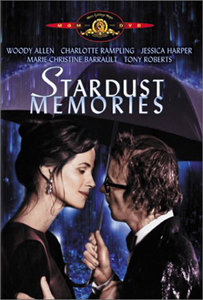“Just deal with it” is my knee-jerk response to celebrities who complain about the price of fame. But in “Stardust Memories” (1980), Sandy Bates – a thinly veiled (OK, not veiled at all) stand-in for Woody Allen, who also plays the role – is so bombarded by fans, many of a ridiculous nature, that I feel for him. Director Allen wisely has cinematographer Gordon Willis either get in Sandy’s face as he’s being mobbed, or in the faces of the admirers, with Sandy as the camera’s POV.
Perils of fame
“Stardust Memories” is about other things, too, but its point – intentional, I think – is that it’s hard to even think straight when so many demands are being made of you, from charity appearances to autographs of a fan’s left breast. A reunion scene between Sandy and Isobel (Marie-Christine Barrault) is interrupted multiple times.
Sandy can multitask – he signs autographs while discussing the future of the relationship – but we perceive his stress simply because this would be stressful to anyone.

“Stardust Memories” (1980)
Director: Woody Allen
Writer: Woody Allen
Stars: Woody Allen, Charlotte Rampling, Jessica Harper
“Stardust” also takes a crack at studio interference. By this point, Allen had figured out how to carve his own path, but he brilliantly and bitterly skewers the process through an arthouse film within the film.
Sandy’s ending has the folks from the rich people’s train end up at a trash heap, but the studio – citing what audiences want at the moment — has them end up with a heavenly jazz band.
Love triangle across time
If that’s not enough, Allen also tells a love-triangle romance story. Charlotte Rampling’s depressive Dorrie is Sandy’s first love, reliable and mature Isobel is his current love, and Jessica Harper’s cute and enigmatic Daisy has him smitten with those first-love feelings again.
All three relationship threads are easy to watch (I especially am left wondering why Harper didn’t become a big star), but I wonder if Allen writes them just so “Stardust” has a foundational plot – something the rabid fans and insane studio bosses can interrupt.
Experimental feel
“Stardust” feels meandering until I figured out that it’s using flashbacks from a film festival to multiple points in the past. Even then, it has a tinge of being experimental. But the more I think about it, the more it strikes me as a smart, complete statement. It offers layers of ridiculousness that get funnier the more you think about them.
Even though the scenes are carefully crafted to not make Sandy seem ungrateful for his success, it can’t be denied that the film purposely casts many weird-looking people in the roles of the nutso fans. This could’ve backfired with some 1980 viewers, but then again, maybe the casting choices are a way to illustrate an extreme. Allen is not talking about you normal fans in the audience, he’s talking about these other weirdos, see?

I suspect “Stardust” has aged well since it came out and Allen has receded from being the man of the hour. It uses the films that precede it in Allen’s catalog as pillars – the early comedies that everyone wishes he’d go back to, the romances, and the one serious film that no one wanted (“Interiors”) – to say something about what it’s like to be in the center of it all.
Despite drawing from everything else, and despite exploring three almost unrelated points, “Stardust Memories” ends up distinguishing itself. It’s one of Allen’s most ambitious and creative efforts, and it particularly illuminates how an otherwise down-to-earth guy feels in the midst of the celebrity hailstorm.

